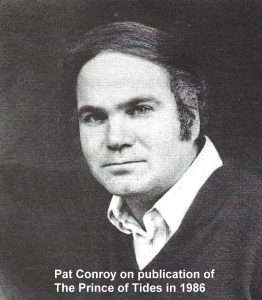It’s time to re-read Pat Conroy’s ‘Prince of Tides’
 Along with Gibbon’s A Scots Quair and Allende’s The House of Spirits, Pat Conroy’s The Prince of Tides (1986) is one of those “comfort food” books that I return to again and again even though it tells the story of a doomed family with some the worst personal events ever consigned to print. Most readers, I think, need “comfort food” books not for the comfort they provide but for familiar stories, beautifully told.
Along with Gibbon’s A Scots Quair and Allende’s The House of Spirits, Pat Conroy’s The Prince of Tides (1986) is one of those “comfort food” books that I return to again and again even though it tells the story of a doomed family with some the worst personal events ever consigned to print. Most readers, I think, need “comfort food” books not for the comfort they provide but for familiar stories, beautifully told.
I suppose most readers are more familiar with The Great Santini and The Lords of Discipline, in part because their stories are more straightforward and the movies were better made. I like all of Conroy’s work but come back to The Prince of Tides because the story is a poem to the South Carolina low country and the flaws of a Southern upbringing of the era in which the book was set.
I grew up in the South along the Florida coast, and I am familiar with the beauty of marshland, tides, fishing, coastal waters, and what Southern society “did wrong,” so I know the tropes typically found in Southern fiction set in the 1950s and 1960s. When I read The Prince of Tides, I see where I came from without the worst of times that confront the Wingo family.
 Conroy in 1986
Conroy in 1986
The San Francisco Chronicle wrote, “A big, sprawling saga of a novel this epic family drama is a masterwork by the #1 New York Times bestselling author of The Great Santini.” Some reviewers would say the book is overwritten and/or that most of Conroy’s work is overwritten. Perhaps so, but I don’t care because the settings and circumstances almost demand that his novels should be overwritten.
From the Publisher“Set in New York City and the low country of South Carolina, The Prince of Tides opens when Tom, a high school football coach whose marriage and career are crumbling, flies from South Carolina to New York after learning of his twin sister’s suicide attempt. Savannah is one of the most gifted poets of her generation, and both the cadenced beauty of her art and the jumbled cries of her illness are clues to the too-long-hidden story of her wounded family. In the paneled offices and luxurious restaurants of New York City, Tom and Susan Lowenstein, Savannah’s psychiatrist, unravel a history of violence, abandonment, commitment, and love. And Tom realizes that trying to save his sister is perhaps his last chance to save himself.
“With passion and a rare gift of language, Pat Conroy moves from present to past, tracing the amazing history of the Wingos from World War II through the final days of the war in Vietnam and into the 1980s, drawing a rich range of characters: the lovable, crazy Mr. Fruit, who for decades has wordlessly directed traffic at the same intersection in the southern town of Colleton; Reese Newbury, the ruthless, patrician land speculator who threatens the Wingos’ only secure worldly possession, Melrose Island; Herbert Woodruff, Susan Lowenstein’s husband, a world-famous violinist; Tolitha Wingo, Savannah’s mentor and eccentric grandmother, the first real feminist in the Wingo family.
“Pat Conroy reveals the lives of his characters with surpassing depth and power, capturing the vanishing beauty of the South Carolina low country and a lost way of life.”
According to Publishers Weekly, the book is, “A seductive narrative, told with bravado, flourishes, portentous foreshadowing, sardonic humor and eloquent turns of phrase. … For sheer storytelling finesse, Conroy will have few rivals.”
As I re-read this familiar novel, I am sick with an infection of unknown origin that I contracted in June and that still has doctors perplexed. Plenty of tests, but no answers. The story fits my mood as I wonder whether or not at my age I can survive this illness. This is why we need comfort books. They help us remain sane because they present greater insanities than we can endure.
–Malcolm



